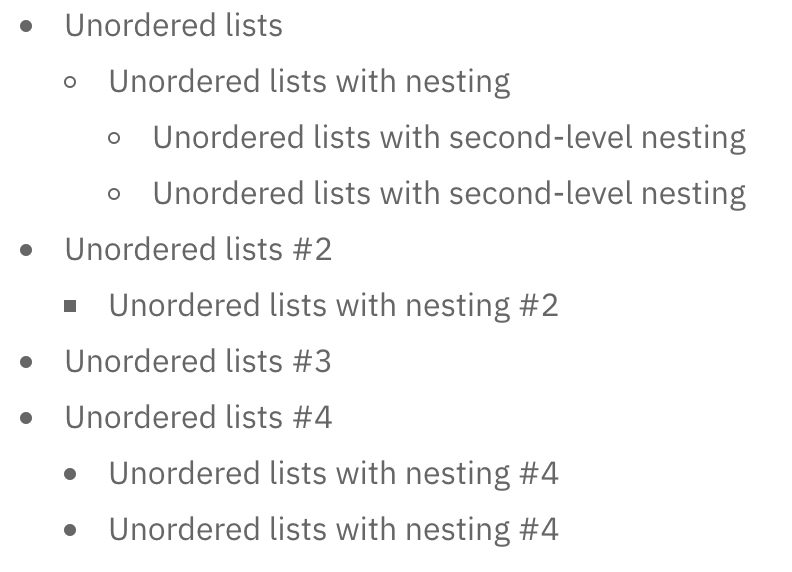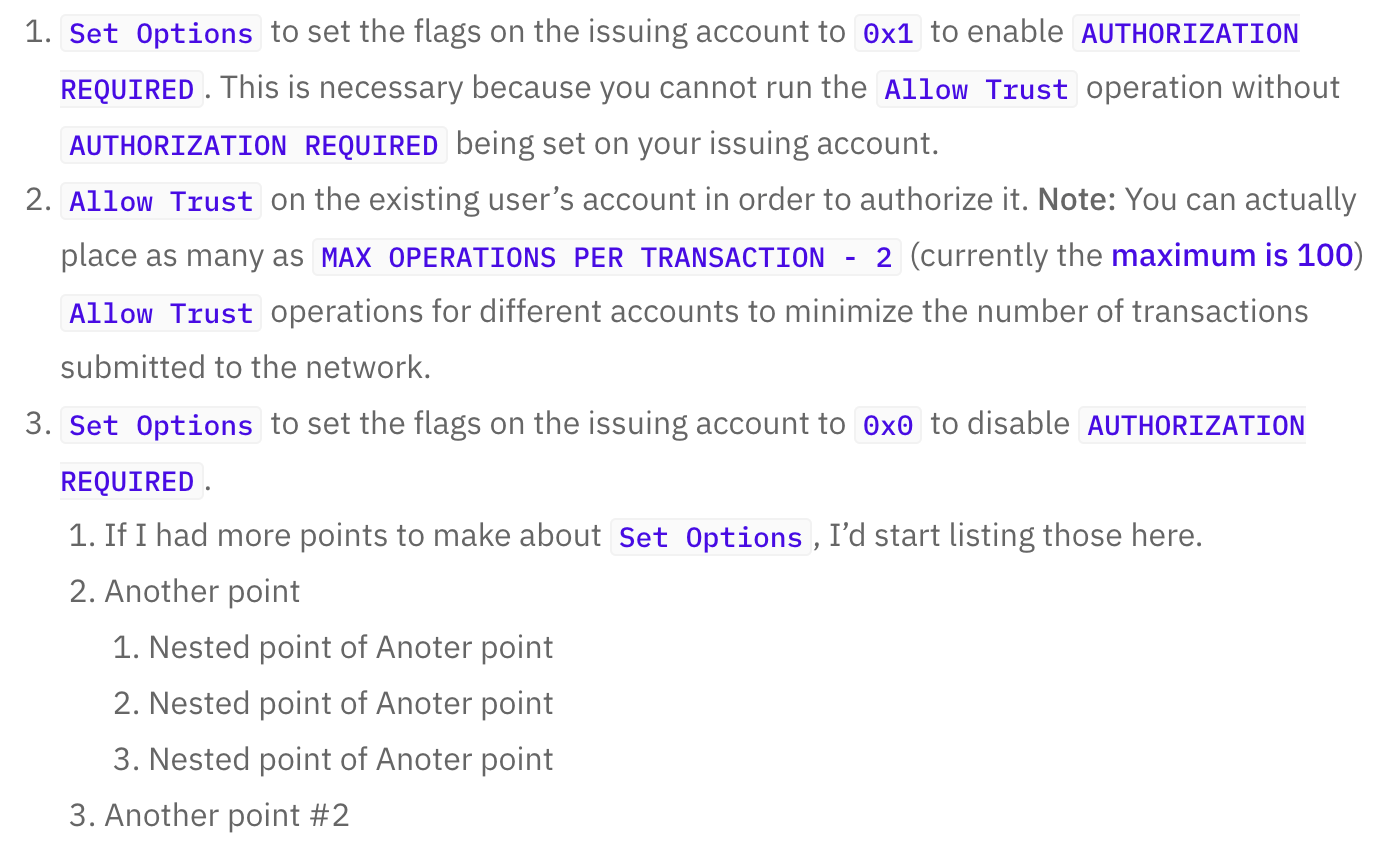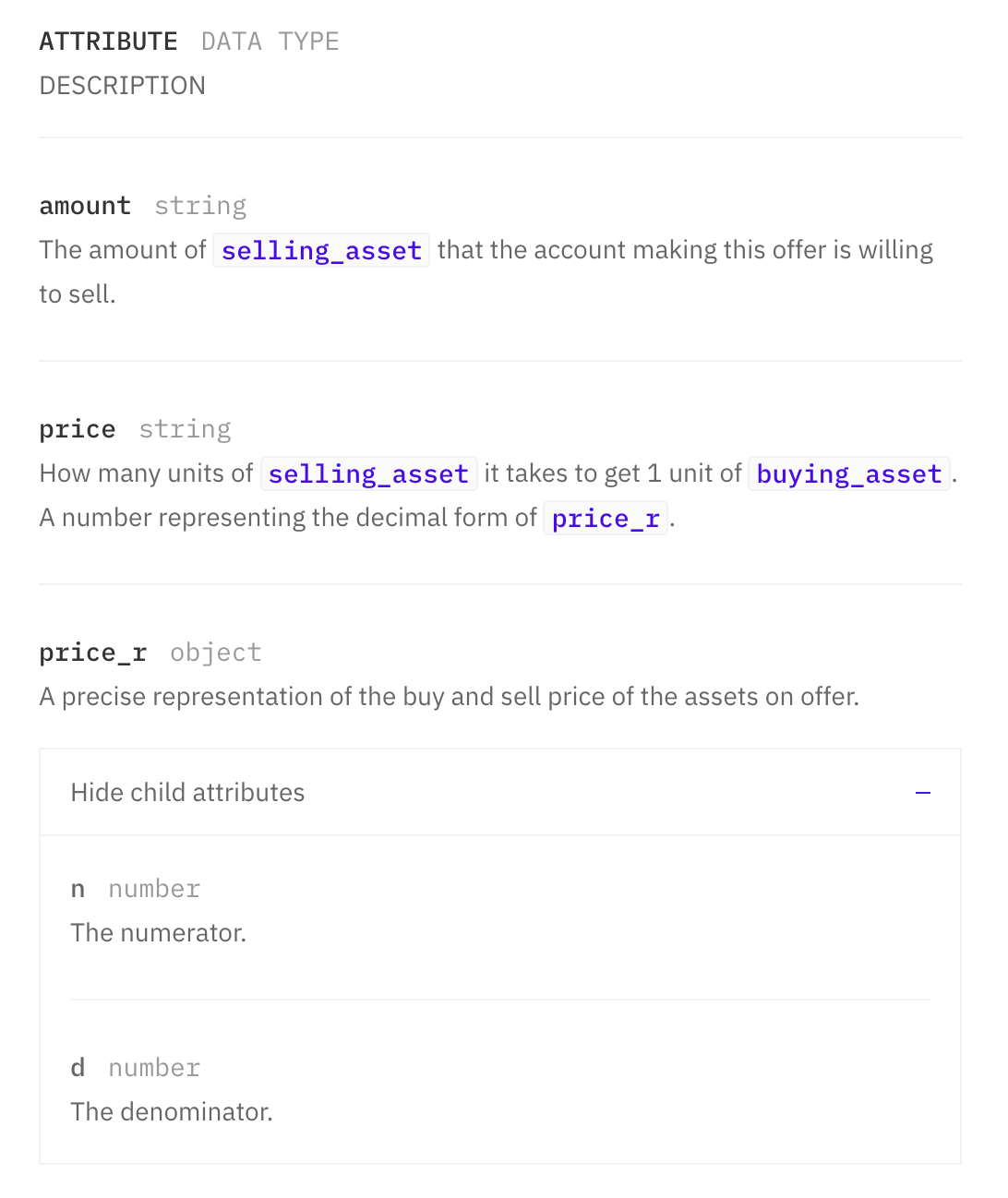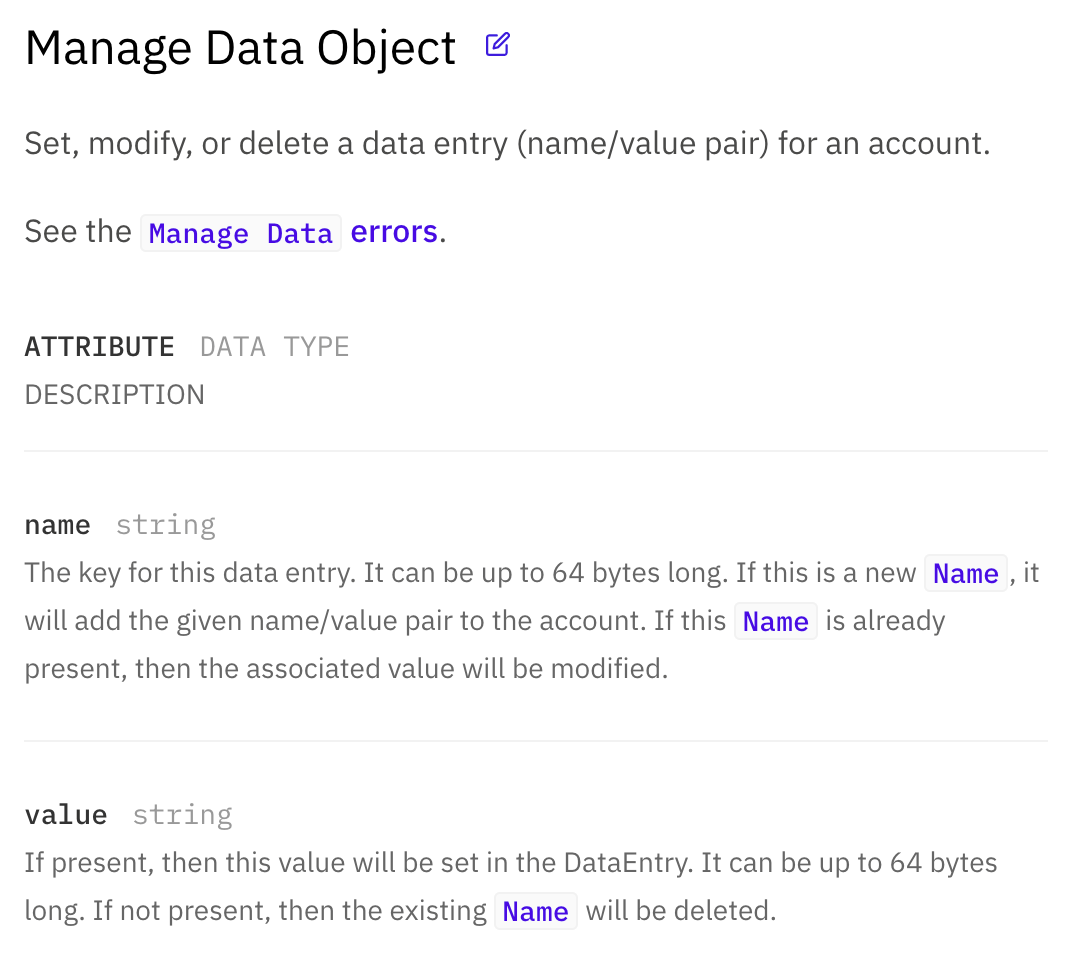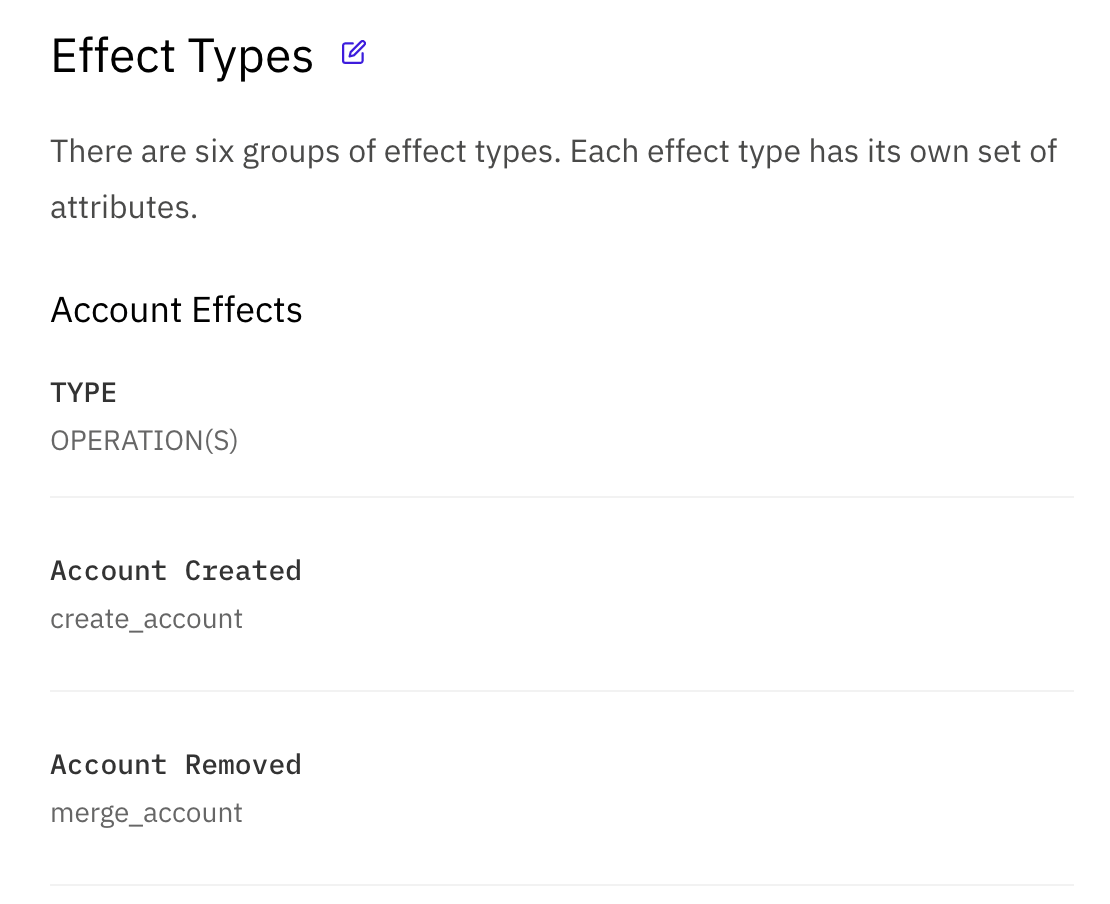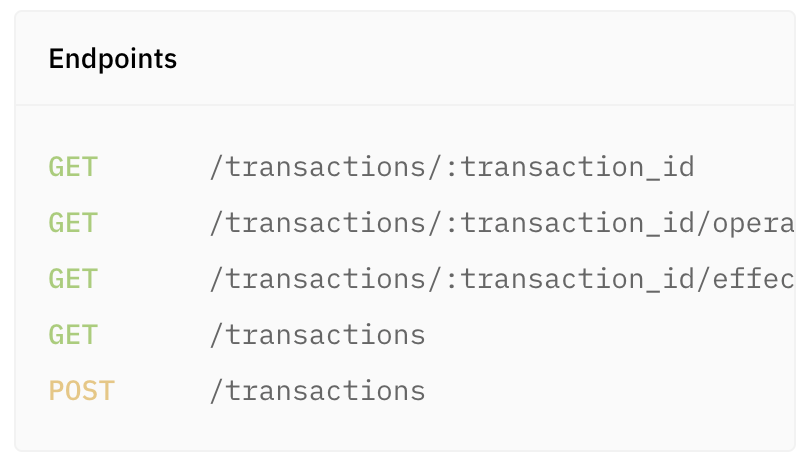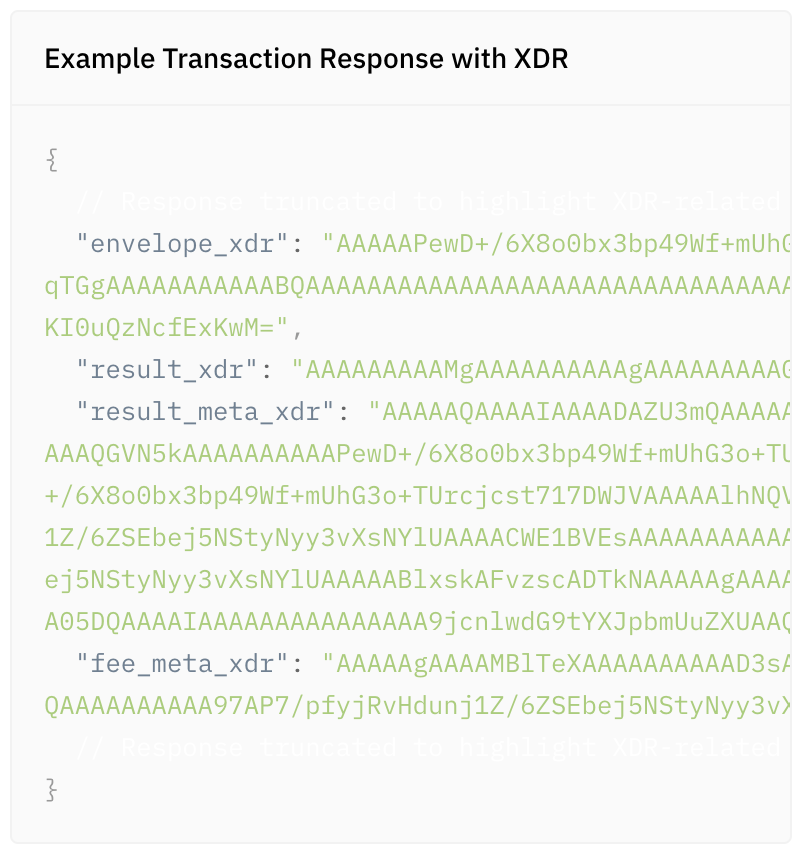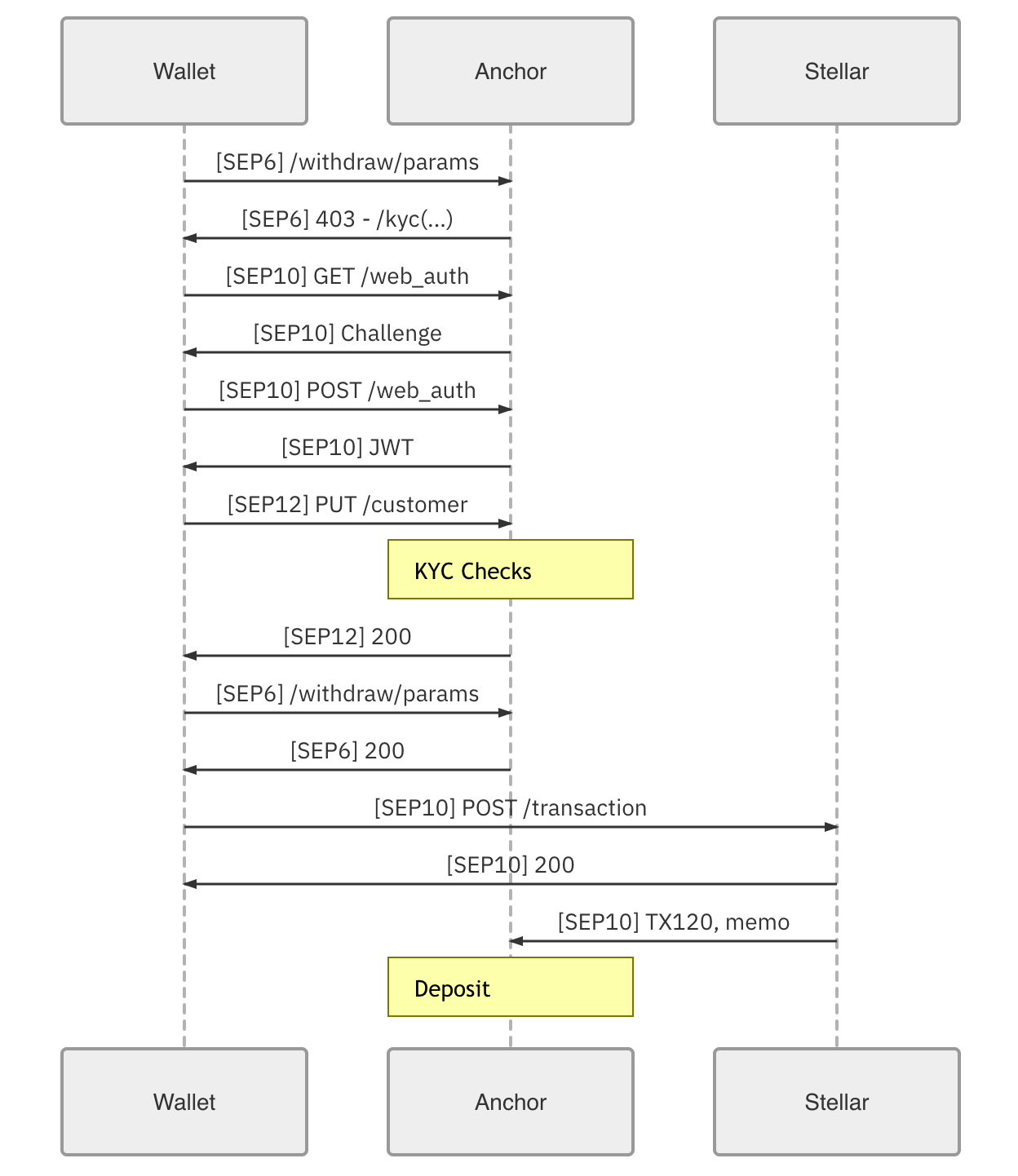Stellar Documentation and API Reference
To build this project, you must have the following dependencies installed:
- A modern version of node. We recommend the current LTS.
- We have some binary dependencies,
sharpfor image processing andpuppeteerto render Mermaid charts, which are both somewhat flaky. It's possible that one of these will ship a change that mandates a more modern version in the future.
- We have some binary dependencies,
yarn
yarn start to start local development.
The build has been dockerized so we can host with nginx on Kubernetes, which can
be compiled and run with yarn scripts. Make sure you have Docker set up on
your machine.
yarn production
# or
yarn prod:build
yarn prod:serveTo run a complete simulation of a production build, make sure to set an
AMPLITUDE_KEY environment variable.
/contentcontains- Documentation
/docs- Web assets
/docs/web-assets
- Web assets
- API Reference
/api - Each page is authored as an
index.mdxdocument.
- Documentation
- Title (og:title, page title): Pulled from front matter.
- Order (order in which a page appears in the table of contents): Pulled from front matter.
- URL slug: Pulled from the folder or file name
All names must use dashes for spaces instead of spaces or underscores
---
title: Node Monitoring and Diagnostics
order: 40
---
Each folder must have a metadata.json file with 2 keys:
- Title (section title in the table of contents): Pulled from a
metadata.jsonfile in the folder - Order (order in which a section appears in the table of contents): Pulled from a metadata.json file in the folder
{
"order": 0,
"title": "Introduction"
}If we want to sort pages in an alphabetical order, add sortMethod in that
folder's metadata.json.
The below example is for /glossary page
{
"order": 60,
"title": "Glossary",
"sortMethod": "alphabetical"
}Folders may be nested, which means that a final URL may be stitched together from multiple metadata files.
Check /content folder to see how its nested order is working
content/
├── api/
│ ├── metadata.json
│ └── aggregations/
│ ├── metadata.json
│ ├── index.mdx
│ └── fee-stats/
│ ├── index.mdx
│ ├── metadata.json
│ ├── object.mdx
│ └── single.mdx
└── docs/
├── metadata.json
├── index.mdx
├── web-assets/
│ └── img.png
└── building-apps/
├── basic-wallet.mdx
├── custom-assets.mdx
├── index.mdx
├── metadata.json
└── connect-to-anchors/
├── deposit-anchored-assets.mdx
├── index.mdx
├── setup-for-anchored-assets.mdx
└── metadata.json
| Field | Requirements | Description |
| --- | --- | --- |
| FEDERATION_SERVER | uses `https://` | The endpoint for clients to resolve stellar addresses for users on your domain via [SEP-2](https://github.com/stellar/stellar-protocol/tree/master/ecosystem/sep-0002.md) Federation Protocol |
| AUTH_SERVER | uses `https://` | The endpoint used for [SEP-3](https://github.com/stellar/stellar-protocol/tree/master/ecosystem/sep-0003.md) Compliance Protocol |
| TRANSFER_SERVER | uses `https://` | The server used for [SEP-6](https://github.com/stellar/stellar-protocol/tree/master/ecosystem/sep-0006.md) Anchor/Client interoperability |
| KYC_SERVER | uses `https://` | The server used for [SEP-12](https://github.com/stellar/stellar-protocol/tree/master/ecosystem/sep-0012.md) Anchor/Client customer info transfer |
| WEB_AUTH_ENDPOINT | uses `https://` | The endpoint used for [SEP-10 Web Authentication](https://github.com/stellar/stellar-protocol/tree/master/ecosystem/sep-0010.md) |
| SIGNING_KEY | Stellar public key | The signing key is used for [SEP-3](https://github.com/stellar/stellar-protocol/tree/master/ecosystem/sep-0003.md) Compliance Protocol |
| HORIZON_URL | url | Location of public-facing Horizon instance (if you offer one) |
| ACCOUNTS | list of `G...` strings | A list of Stellar accounts that are controlled by this domain |
| VERSION | string | The version of SEP-1 your `stellar.toml` adheres to. This helps parsers know which fields to expect. |
| URI_REQUEST_SIGNING_KEY | Stellar public key | The signing key is used for [SEP-7](https://github.com/stellar/stellar-protocol/tree/master/ecosystem/sep-0007.md) delegated signing |
- Unordered lists
- Unordered lists with nesting
- Unordered lists with second-level nesting
- Unordered lists with second-level nesting
- Unordered lists #2
- Unordered lists with nesting #2
- Unordered lists #3
- Unordered lists #4
- Unordered lists with nesting #4
- Unordered lists with nesting #4
1. [`Set Options`](../api/resources/operations/object/set-options.mdx) to set the flags on the issuing account to `0x1` to enable `AUTHORIZATION REQUIRED`. This is necessary because you cannot run the [`Allow Trust`](../api/resources/operations/object/allow-trust.mdx) operation without `AUTHORIZATION REQUIRED` being set on your issuing account.
1. [`Allow Trust`](../api/resources/operations/object/allow-trust.mdx) on the existing user's account in order to authorize it. **Note:** You can actually place as many as `MAX OPERATIONS PER TRANSACTION - 2` (currently the [maximum is 100](concepts/transactions.md#list-of-operations)) `Allow Trust` operations for different accounts to minimize the number of transactions submitted to the network.
1. [`Set Options`](../api/resources/operations/object/set-options.mdx) to set the flags on the issuing account to `0x0` to disable `AUTHORIZATION REQUIRED`.
1. If I had more points to make about `Set Options`, I'd start listing those here.
1. Another point
1. Nested point of Anoter point
1. Nested point of Anoter point
1. Nested point of Anoter point
1. Another point #2
Currently (April, 2020), only Documentation uses images.
- Drop the images in the
content/docs/web-assetsfolder - Refer to the asset as
in the proper location in your file - make sure thatweb-assets' relative path is correct - Captions: Include alt text if you’d like a caption:
Leave the alt text section blank if you do not want a caption:
> Here's a quote
Beyond defining title font sizes, line heights, and weights:
- H1 tags are reserved for the page’s title and should not be used; that said, if they are used, they will still show up on the front end as H1 tags
- H2 tags populate the ride-side page table of contents in Documentation
Custom (React) components that are being used throughout Documentation and API Reference.
Make sure that there is an empty line within the wrapper
For example,
<Alert>
<!-- EMPTY SPACE IS NEEDED BELOW FOR A COMPONENT TO RENDER PROPERLY -->
Note: the testnet is reset every three months, so when building on it, make sure you have a plan to recreate necessary accounts and other data. For more info, check out the [best practices for using the testnet](../glossary/testnet.mdx#best-practices-for-using-testnet).
<!-- EMPTY SPACE IS NEEDED BELOW FOR A COMPONENT TO RENDER PROPERLY -->
</Alert>
<AttributeTable/> explains each attribute or argument that is being used.
Nested table will turn into "child attributes" that are collapsed by default
(See prices_r and its child attributes from the example above).
- PropTypes
children(required)
For example, Api Reference > Resources > Operations > Object
import { AttributeTable } from "components/AttributeTable";
<AttributeTable>
- ATTRIBUTE
- DATA TYPE
- DESCRIPTION
- amount
- string
- The amount of `selling_asset` that the account making this offer is willing to sell.
- price
- string
- How many units of `selling_asset` it takes to get 1 unit of `buying_asset`. A number representing the decimal form of `price_r`.
- price_r
- object
- A precise representation of the buy and sell price of the assets on offer.
- n
- number
- The numerator.
- d
- number
- The denominator.
</AttributeTable>
Data Type is not required. If you want to skip it, simply add a text "skip" in
it
import { AttributeTable } from "components/AttributeTable";
<AttributeTable>
- TYPE
- skip
- OPERATION(S)
- Account Created
- skip
- create_account
- Account Removed
- skip
- merge_account
</AttributeTable>
Example: <AttributeTable/> without type specified on
API's Manage Data Object.
Example: <AttributeTable/> with type specified on
API's Effect Types.
<Alert/> is used to convey hints, warnings, and etc.
- PropTypes
children(required)
For example, Setting Up Test Server
import { Alert } from "components/Alert";
<Alert>
Note: the testnet is reset every three months, so when building on it, make sure you have a plan to recreate necessary accounts and other data. For more info, check out the [best practices for using the testnet](../glossary/testnet.mdx#best-practices-for-using-testnet).
</Alert>
<CodeExample/> is a code snippet component. You can include snippets for more
than one language. See an example of including a snippet for curl and
JavaScript below. It is using
Prism syntax highlighting library.
- PropTypes
title(optional)children(required)href(optional)
For example, Setting Up Test Server in Documentation and Resources > Transaction > Retrieve a Transaction in API Reference.
import { CodeExample } from "components/CodeExample";
<CodeExample title="Example Request">
```curl
curl "https://horizon.stellar.org/ledgers/27147222/transactions?limit=2"
```
```js
var StellarSdk = require('stellar-sdk')
var server = new StellarSdk.Server('https://horizon.stellar.org')
server
.transactions()
.forLedger('27147222')
.call()
.then(function(resp) {
console.log(resp)
})
.catch(function(err) {
console.error(err)
})
```
</CodeExample>
Languages that are currently being used in Documentation and API Reference are below:
// https://github.com/stellar/new-docs/blob/master/src/components/CodeExample.js
const CODE_LANGS = {
bash: "bash",
cpp: "C++",
curl: "cURL",
go: "Go",
html: "html",
java: "Java",
js: "JavaScript",
json: "json",
python: "Python",
scss: "SCSS",
toml: "TOML",
ts: "TypeScript",
tsx: "TSX",
yaml: "YAML",
};
If you would like to add an additional language to this, visit
CodeExample.js
and add it to CODE_LANGS.
<Endpoint/> is currently used in API Reference.
- PropTypes
children(required)
For example, Aggregations > Order Books > Retrieve an Order Book.
import { Endpoint } from "components/Endpoint";
<Endpoint>
| | |
| --- | ---------------------------- |
| GET | /order_book?selling_asset_type={native,credit_alphanum4,credit_alphanum12}&selling_asset_issuer={:account_id}&selling_asset_code{:asset_code}&buying_asset_type={native,credit_alphanum4,credit_alphanum12}&buying_asset_issuer={:account_id}&buying_asset_code{:asset_code}&limit={1-200} |
</Endpoint>
<EndpointsTable/> displays an endpoint and its
HTTP method.
- PropTypes
title(required)children(required)
For example, Resources > Transactions.
import { EndpointsTable } from "components/EndpointsTable";
<EndpointsTable title="Endpoints">
| | |
| --- | ------------------------------------------------------------- |
| GET | [/transactions/:transaction_id](./single.mdx) |
| GET | [/transactions/:transaction_id/operations](./operations.mdx) |
| GET | [/transactions/:transaction_id/effects](./effects.mdx) |
| GET | [/transactions](./list.mdx) |
| POST | [/transactions](./post.mdx) |
</EndpointsTable>
<ExampleResponse/> is only used in API Reference for JSON response. In
Documentation, we use <CodeExample/> for JSON response.
- PropTypes
title(optional)children(required)
For example, Introduction > XDR.
import { ExampleResponse } from "components/ExampleResponse";
<ExampleResponse title="Example Transaction Response with XDR">
```json
{
// Response truncated to highlight XDR-related attributes
"envelope_xdr": "AAAAAPewD+/6X8o0bx3bp49Wf+mUhG3o+TUrcjcst717DWJVAAAAyAFvzscADTkNAAAAAAAAAAAAAAACAAAAAAAAAAYAAAACWE1BVEsAAAAAAAAAAAAAAAPvNOuztX4IjvV8pztsEc1/ZnTz0G3p5Cx4vcf04+xUAAONfqTGgAAAAAAAAAAABQAAAAAAAAAAAAAAAAAAAAAAAAAAAAAAAAAAAAAAAAABAAAAD2NyeXB0b21hcmluZS5ldQAAAAAAAAAAAAAAAAF7DWJVAAAAQK3vfUCZ8mbjW3ssMd0n1tJTF9Fv6EbuJ6cWKkYXBqG5itqanPbFzIQoZEHbPS8nr2vo4dROvKI0uQzNcfExKwM=",
"result_xdr": "AAAAAAAAAMgAAAAAAAAAAgAAAAAAAAAGAAAAAAAAAAAAAAAFAAAAAAAAAAA=",
"result_meta_xdr": "AAAAAQAAAAIAAAADAZU3mQAAAAAAAAAA97AP7/pfyjRvHdunj1Z/6ZSEbej5NStyNyy3vXsNYlUAAAAABlxskAFvzscADTkMAAAAAgAAAAAAAAAAAAAAD2NyeXB0b21hcmluZS5ldQABAAAAAAAAAAAAAAAAAAAAAAAAAQGVN5kAAAAAAAAAAPewD+/6X8o0bx3bp49Wf+mUhG3o+TUrcjcst717DWJVAAAAAAZcbJABb87HAA05DQAAAAIAAAAAAAAAAAAAAA9jcnlwdG9tYXJpbmUuZXUAAQAAAAAAAAAAAAAAAAAAAAAAAAIAAAACAAAAAwGVN5gAAAABAAAAAPewD+/6X8o0bx3bp49Wf+mUhG3o+TUrcjcst717DWJVAAAAAlhNQVRLAAAAAAAAAAAAAAAD7zTrs7V+CI71fKc7bBHNf2Z089Bt6eQseL3H9OPsVAAATfBgJfPoAAONfqTGgAAAAAABAAAAAAAAAAAAAAABAZU3mQAAAAEAAAAA97AP7/pfyjRvHdunj1Z/6ZSEbej5NStyNyy3vXsNYlUAAAACWE1BVEsAAAAAAAAAAAAAAAPvNOuztX4IjvV8pztsEc1/ZnTz0G3p5Cx4vcf04+xUAABN8GAl8+gAA41+pMaAAAAAAAEAAAAAAAAAAAAAAAIAAAADAZU3mQAAAAAAAAAA97AP7/pfyjRvHdunj1Z/6ZSEbej5NStyNyy3vXsNYlUAAAAABlxskAFvzscADTkNAAAAAgAAAAAAAAAAAAAAD2NyeXB0b21hcmluZS5ldQABAAAAAAAAAAAAAAAAAAAAAAAAAQGVN5kAAAAAAAAAAPewD+/6X8o0bx3bp49Wf+mUhG3o+TUrcjcst717DWJVAAAAAAZcbJABb87HAA05DQAAAAIAAAAAAAAAAAAAAA9jcnlwdG9tYXJpbmUuZXUAAQAAAAAAAAAAAAAAAAAAAA==",
"fee_meta_xdr": "AAAAAgAAAAMBlTeXAAAAAAAAAAD3sA/v+l/KNG8d26ePVn/plIRt6Pk1K3I3LLe9ew1iVQAAAAAGXG1YAW/OxwANOQwAAAACAAAAAAAAAAAAAAAPY3J5cHRvbWFyaW5lLmV1AAEAAAAAAAAAAAAAAAAAAAAAAAABAZU3mQAAAAAAAAAA97AP7/pfyjRvHdunj1Z/6ZSEbej5NStyNyy3vXsNYlUAAAAABlxskAFvzscADTkMAAAAAgAAAAAAAAAAAAAAD2NyeXB0b21hcmluZS5ldQABAAAAAAAAAAAAAAAAAAAA"
// Response truncated to highlight XDR-related attributes
}
```
</ExampleResponse>
<MethodTable/> is used to display navigation sections and its description.
- PropTypes
title(required)children(required)
For example, Introduction.
import { MethodTable } from "components/MethodTable";
<MethodTable title="API Reference Sections">
| | |
| --- | --- |
| [Introduction](../introduction/index.mdx) | How Horizon is structured. |
| [Resources](../resources/index.mdx) | Descriptions of resources and their endpoints. |
| [Aggregations](../aggregations/index.mdx) | Descriptions of specialized endpoints. |
| [Errors](../errors/index.mdx) | Potential errors and what they mean. |
</MethodTable>
We're using Mermaid for diagrams.
```mermaid
sequenceDiagram
participant W as Wallet
participant A as Anchor
participant S as Stellar
W->>A: [SEP6] /withdraw/params
A->>W: [SEP6] 403 - /kyc(...)
W->>A: [SEP10] GET /web_auth
A->>W: [SEP10] Challenge
W->>A: [SEP10] POST /web_auth
A->>W: [SEP10] JWT
W->>A: [SEP12] PUT /customer
Note over A: KYC Checks
A->>W: [SEP12] 200
W->>A: [SEP6] /withdraw/params
A->>W: [SEP6] 200
W->>S: [SEP10] POST /transaction
S->>W: [SEP10] 200
S->>A: [SEP10] TX120, memo
Note over A: Deposit
```
We have support for simple, anonymous metrics, emitted to Amplitude via
helpers/metrics.js.
We also have a simple performance tracking system, helpers/performance.js.
mark(string) will begin measuring, and measure(string) will stop measuring
and return timing information—an object with a duration and
hasHighPrecision. Some browsers don't expose the high-precision APIs, and we
definitely want to know if they're used (especially if not usable). Make sure to
use a constants/performanceMarks constant, not just a raw string.
Chrome allows you to override the user agent with DevTools, which enables us to test how Google will see pages.

